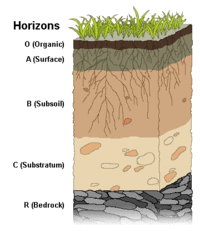Bedrock: Difference between revisions
No edit summary |
No edit summary |
||
| (One intermediate revision by one other user not shown) | |||
| Line 5: | Line 5: | ||
=Composition= | =Composition= | ||
Bedrock specifically refers to the rock layer closest to the surface, after all the organic material, soil, loose rocks, and other materials are removed. Bedrock can be any of the three rock types; Sedimentary, Metamorphic, and Igneous, in origin. Further rock layers below the bedrock are referred to as rockhead. The depth of regolith can range from nonexistent to extremely deep, depending on location. | Bedrock specifically refers to the rock layer closest to the surface, after all the organic material, [[soil]], loose rocks, and other materials are removed. Bedrock can be any of the three rock types; Sedimentary, Metamorphic, and Igneous, in origin. Further rock layers below the bedrock are referred to as rockhead. The depth of regolith can range from nonexistent to extremely deep, depending on location. | ||
=Soil Formation= | =Soil Formation= | ||
| Line 26: | Line 26: | ||
[3]https://mrdata.usgs.gov/geology/state/ | [3]https://mrdata.usgs.gov/geology/state/ | ||
. | |||
Latest revision as of 17:23, 11 March 2022
Overview
Bedrock is the term for the solid rock layer that lies below the looser regolith of an area.

Composition
Bedrock specifically refers to the rock layer closest to the surface, after all the organic material, soil, loose rocks, and other materials are removed. Bedrock can be any of the three rock types; Sedimentary, Metamorphic, and Igneous, in origin. Further rock layers below the bedrock are referred to as rockhead. The depth of regolith can range from nonexistent to extremely deep, depending on location.
Soil Formation
Soil Formation, or Pedogenesis, is the term used to describe the steady weathering of the bedrock as it moves up the Soil Horizons from the R Horizon (solid rock) to the A and O horizons. As the rock is broken down into smaller and smaller pieces. The Jenny Equation, or CLORPT equation refers to bedrock as P, or parent material. [1]
Resources
ROCKD[2] is a free website and app that provides an interactive bedrock map of the whole world.
State maps can be found here: https://mrdata.usgs.gov/geology/state/[3]
References
[1]https://www.nrcs.usda.gov/wps/PA_NRCSConsumption/download?cid=nrcseprd1330210&ext=pdf
[3]https://mrdata.usgs.gov/geology/state/
.